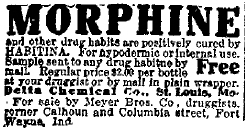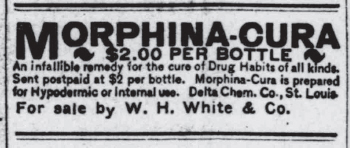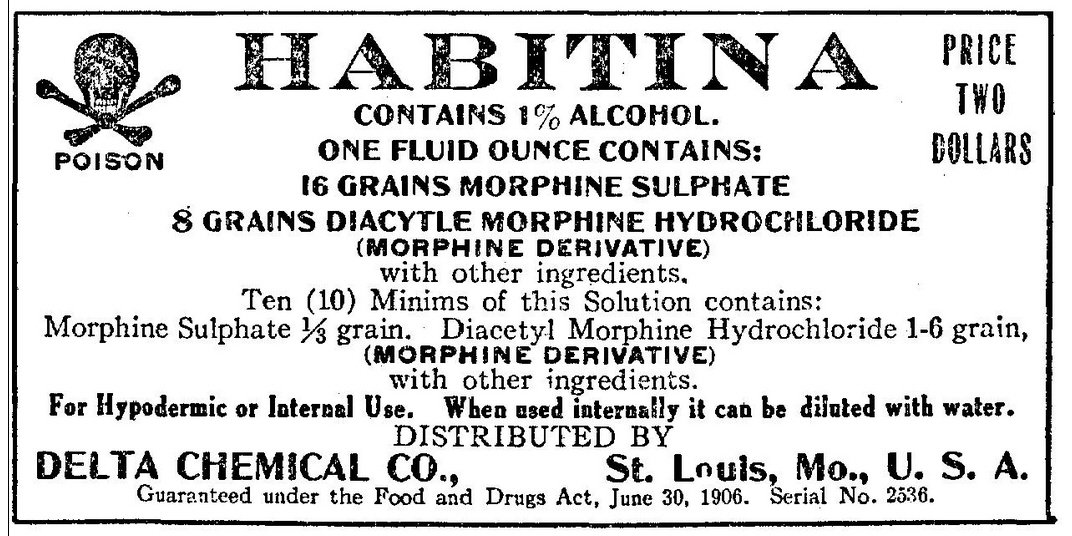 Source: The Fort Wayne Journal-Gazette,17 April 1907
Source: The Fort Wayne Journal-Gazette,17 April 1907
——————————————————————————————
Following on from the last post, we remain in early 20th-century America. But while Mayr’s Wonderful Stomach Remedy was fairly harmless (albeit rather revolting), this nostrum was notorious for the damage it caused in just 6 years of existence. Between 1906 and 1912, the Delta Chemical Company made more than half a million dollars by supplying morphine addicts with its own branded version of the narcotic.
The company was run by Dr Robert Prewitt and Ryland C. Bruce. Prewitt’s medical qualification was genuine, but he never had much success as a practising physician, trying his hand at surgical instrument selling in Little Rock, AR, until this venture went down the pan. He then became a travelling salesman for various chemical companies and ended up working at a St Louis sanatorium that ran a mail-order addiction cure business on the side.
Prewitt, in partnership with former insurance salesman Bruce, took over this business in 1906 and started to think big. They traded as the Delta Chemical Company and dubbed their product Morphina-Cura, an ‘infallible remedy’ for drug habits of all kinds.

The product name changed to Habitina in 1907, probably because titling something a ‘cure’ could lead to allegations of misbranding under the Pure Food and Drug Act. Addicts – then often referred to as habitués – were advised to ‘discontinue the use of all narcotic drugs and take sufficient HABITINA to support the system without any of the old drug.’ They should then gradually decrease the dose until they stopped taking it altogether.
This was in line with reputable medical practice, but for addicted patients with no supervision, life didn’t work out according to the instructions. Habitina contained 16 grains (approx 1g) of morphine sulphate and 8 grains of heroin per fl. oz. It was simply a more expensive way of continuing to take huge hits of narcotics – and of course the money went straight into Prewitt and Bruce’s pockets. The company hooked people in with free samples, and although they claimed to make patients answer a questionnaire, in reality they would send the freebies out to anyone who asked.
In 1912, Prewitt officially changed his name to Gregg because of his wife’s father’s will. Old man Gregg stipulated that his daughter must keep her maiden name or forfeit her inheritance of $50,000. Her first husband had gone along with it without changing his own name, but romantic Prewitt decided to be at one with his spouse, and the couple became Dr and Mrs Robert Prewitt Gregg.
Just a few months later, however, Prewitt’s fortunes changed. He and Ryland Bruce were arrested and charged with sending poison through the mail and with using the mail for a scheme to defraud. The trial revealed the devastating effect of Habitina on its victims, several of whom testified in court.
Some had experienced periods of insanity – Missouri mechanic Mr. H. I. C. lost everything and became a ‘maniac’ consuming a whole $2 bottle of Habitina every day. Mrs M. P. of Pennsylvania lost her reason and went blind as a result of taking the medicine, but hospital treatment eventually cured her addiction.
Perhaps the most tragic case is 26-year-old Mrs G. M. S., who spent more than $2,300 on Habitina over the course of 5 years, even going without shoes to be able to afford it. At the time of the trial she was still addicted.
Prewitt and Bruce were found guilty on both counts, fined $2000 each and sentenced to five years’ hard labour. It would be nice to end on that note, but the pair appealed. At the appeal court, Judge Munger dismissed the count of sending poison through the mail, as registered physicians were still permitted to do this, and sent the second count – the scheme to defraud – to a new trial.
At this point, I must own up to an epic fail, because I haven’t been able to find out anything about the second trial – if anyone can point me towards any sources, I’d be grateful. I imagine Prewitt and Bruce were acquitted because being unscrupulous doesn’t necessarily amount to a crime. They were careful to remain within the law as regards labelling their product, and made it very clear that Habitina contained morphine and that a cure would only result from a gradual reduction in dose.
They surely knew that they would make a fortune from addicts who would take it willy-nilly for years, but even with my lack of legal knowledge, I suspect this couldn’t technically be defined as a scheme to defraud. As you can see from the bottle label, they weren’t exactly misleading people about what was in it:




Thnaks for another fascinating tale.
The Quack Doctor might find today’s post in Science-Based Medicine interesting.
See http://tiny.cc/mg3no
It tells the story of the FDA (Food and Drug Administration), and how it developed in response to quacks like Prewitt and Bruce, and has had to fight powerful vested interests.
Thanks for the link, Michael – very interesting. I’ll bookmark that for future reference.
Interesting story and write-up. I’m always collecting stories of “treatments” for various ailments, so I’m glad to read this via the history carnival
…………………… uhmmmm yupp? im doing a history project on the Pure food and drug act???!!!:).
…………………… uhmmmm yupp? im doing a history project on the Pure food and drug act???!!!:).
……………………………….